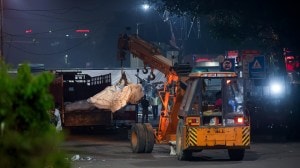In Farm fire numbers, Punjab’s big success story: 92% dip in 5 years
Experts thank residue machines, techniques and alternative farming practices
 The reduction in stubble fires has been particularly notable in high-incidence districts. (File Photo)
The reduction in stubble fires has been particularly notable in high-incidence districts. (File Photo)Punjab has registered a 92 per cent decline in the number of paddy stubble burning cases in over the past five years. According to the data released by the Punjab Pollution Control Board (PPCB), the number of farm fires dropped significantly each year, with Punjab recording just 4,732 farm fires between September 15 and November 13 in 2025, compared to 62,718 in 2021. The year-wise data reflects this encouraging trend.
The PPCB data comes a day after the Supreme Court directed Punjab to submit a report on its stubble burning control efforts.
The reduction in stubble fires has been particularly notable in high-incidence districts. For example, Sangrur, Firozpur, and Patiala have shown significant drops in the number of fires, with reductions ranging from 83% to 95% over the past five years. These reductions indicate that Punjab is making significant headway in mitigating its contribution to air pollution, despite the challenges posed by the agricultural sector’s reliance on stubble burning.
Though there is a reduction in farm fires across all districts of Punjab compared to last year barring Fazilka and Ludhiana. Fazilka reported 205 farm fire cases this year against 94 last year between September 15 to November 13, and Ludhiana has reported 189 cases against 177 last year, so there is an increase of 118% in Fazilka and 6.7% in Ludhiana.
 There is a reduction in farm fires across all districts of Punjab compared to last year barring Fazilka and Ludhiana.
There is a reduction in farm fires across all districts of Punjab compared to last year barring Fazilka and Ludhiana.
In 2021, Punjab saw its highest single-day farm fires at 5,327 on November 4. In 2022, the highest single-day count was 3,916 fires on November 11. The next year, 2023, recorded 3,230 fires on November 5. In 2024, the peak was 1,251 fires on November 18. This year, 2025, the highest number so far was 442 fires on November 1.
PPCB officials attribute this trend to multiple factors, including the widespread adoption of over 1.5 lakh crop residue management machines, enhanced residue management techniques, government initiatives promoting alternative farming practices, and growing farmer awareness regarding the environmental impact of stubble burning. Although these figures reflect substantial progress, the state acknowledges that there’s still work to be done to reduce farm fires to zero.
As Delhi grapples with a persistent haze, with its Air Quality Index (AQI) remaining in the ‘severe’ category for the third consecutive day, stubble burning in Punjab has once again become a focal point of political blame. This year, Delhi Environment Minister Manjinder Singh Sirsa accused Punjab’s farm fires of exacerbating Delhi’s pollution. However, data from both the Central Pollution Control Board (CPCB) and the Punjab Pollution Control Board (PPCB) suggests a different narrative.
The AQI levels in Punjab during the peak stubble burning season (October-November) have remained in the moderate to satisfactory range for the most part. On a few days, it has dipped into the poor category, particularly around Diwali. Throughout October, Patiala recorded satisfactory and moderate AQI, with only brief periods of poor air quality on October 21 and 22 (Diwali days).
In November, the AQI remained mostly moderate, except for a poor reading on November 1, 23, and 8. Amritsar recorded a good and moderate AQI for the entire month of October, with poor air quality only on October 20, 22, and 28. In November, it recorded moderate and satisfactory AQI for most of the month, except for a single poor reading on November 8. Bathinda’s air quality remained good and satisfactory for most of October, with moderate readings on five days and poor AQI on six days. In November, the AQI has remained satisfactory and moderate, except for a poor reading on November 7.
Ropar recorded good and satisfactory AQI for the entire month of October, except on October 21 and 26, when it was moderate. In November, the city has continued to report satisfactory and moderate air quality. Jalandhar had moderate AQI for most of November, with the exception of a few days in the poor category. The city’s air quality remained satisfactory and moderate for the entire month of October, except for a few days, including October 21–23 and October 29.
In October, Khanna recorded satisfactory and moderate AQI on most days, with poor readings on October 22 and 29. In November, Khanna’s AQI ranged from moderate to poor, with a very poor reading on one day. Ludhiana’s AQI was mainly moderate and satisfactory throughout October, with exceptions on October 20, 22, 23, 25, and 26. In November, Ludhiana’s AQI has remained moderate except for November 4 and November 9, when the AQI was poor. Mandi Gobindgarh showed good, satisfactory, and moderate AQI for the entire month of October, except for five days, including October 18, 20, and 22. In November, the AQI was mostly moderate, with one day in the very poor category.
“The data clearly shows that the air quality has remained relatively stable and within acceptable limits. This casts doubt on the repeated allegations that Punjab’s stubble burning is the primary contributor to the deteriorating air quality in Delhi,” said a PPCB officer.
This year, Diwali was celebrated on October 20 and 21, and stubble burning on these days in Punjab was considerably low. Data from farm fire reports shows a remarkable year-on-year decrease in Diwali-night farm fires. In 2021, Punjab recorded 5,327 farm fires on Diwali night, but in 2025, this number dropped to just 45 — the lowest in five years.
Despite this, the political rhetoric around the role of Punjab’s stubble burning in Delhi’s air quality continues.
Experts have pointed out that local sources of pollution in Delhi, including vehicular emissions, industrial pollutants, and firecracker use, are significant contributors to the capital’s poor air quality. As one air quality researcher put it, “It is misleading and overly simplistic to place the blame entirely on Punjab.”
Punjab Agriculture Minister Gurmeet Singh Khuddian said that there is no scientific proof to support the claim that stubble burning in the state is significantly affecting Delhi’s AQI. “If AQI in Punjab remains in satisfactory and moderate categories, even during the stubble burning season, it’s illogical to blame it for Delhi’s pollution, which is located hundreds of kilometers away,” Khuddian said.
Even Judge Sudhir Agarwal, a former judge of the National Green Tribunal, had questioned the validity of blaming Punjab for Delhi’s pollution during a seminar in Delhi last year. He pointed out that Punjab is geographically distant from Delhi and shares more borders with Haryana and Uttar Pradesh. He emphasised that there is no consistent wind pattern to carry smoke from Punjab to Delhi, and the nature of Delhi’s pollution, which contains more oil-based particles, is inconsistent with the dry stubble smoke of Punjab.
Despite the challenges posed by floods and unpredictable weather patterns, the Punjab Agriculture Department has committed to continuing efforts to reduce stubble burning.
Jaswant Singh, Director of the Punjab Agriculture Department, explained that Punjab farmers are facing a lot of blame despite they faced devastating floods of 2025 left farmers with fields covered in silt, which has delayed the sowing of the next crop. However, the state is working diligently to clear the silt and support farmers in resuming their agricultural activities.
“Punjab’s progress in reducing stubble burning is commendable, but we still have work to do,” said PPCB officials.







